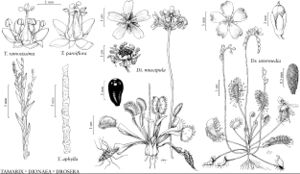FNA>Volume Importer |
imported>Volume Importer |
||
| (2 intermediate revisions by 2 users not shown) | |||
| Line 61: | Line 61: | ||
|publication year= | |publication year= | ||
|special status= | |special status= | ||
| − | |source xml=https:// | + | |source xml=https://bitbucket.org/aafc-mbb/fna-data-curation/src/2e0870ddd59836b60bcf96646a41e87ea5a5943a/coarse_grained_fna_xml/V6/V6_792.xml |
}}<!-- | }}<!-- | ||
-->[[Category:Treatment]] | -->[[Category:Treatment]] | ||
Latest revision as of 22:23, 5 November 2020
Herbs, annual or perennial, carnivorous, scapose. Leaves in basal rosettes (alternate-cauline in Drosera intermedia); stipulate or estipulate; petiolate; blade infolded or circinate in vernation, modified as hinged, jawlike trap (Dionaea) [Aldrovanda] or bearing mucilage-tipped, irritable, multicelled hairs (Drosera) [Drosophyllum]. Inflorescences terminal, umbel-like cymes (Dionaea) or lateral, circinate or scorpioid cymes (Drosera), multiflowered (rarely 1-flowered). Flowers: perianth and androecium hypogynous; sepals 5, distinct or connate basally; petals 5, distinct; stamens usually 5 (Drosera) or (10–)15(–20) (Dionaea), distinct or sometimes connate basally; pistils 1, compound, 3–5-carpellate; ovary superior, 1-locular; placentation basal (Dionaea) or parietal (Drosera); styles 1 and undivided (Dionaea) or 3[5] and bifid (Drosera); stigma plumose (Dionaea) or capitate (Drosera). Fruits capsular.
Distribution
Nearly worldwide.
Discussion
Genera 4, species ca. 175 (2 genera, 9 species in the flora).
Droseraceae comprise carnivorous plants with an unusual, worldwide distribution. They live mostly in sunny, low-nutrient, moist-to-wet acidic sands, clays, seeps, and peat bogs, often subjected to periodic fires. They catch rather small prey in jawlike traps (Aldrovanda Linnaeus and Dionaea) or on sticky glandular hairs (Drosera and Drosophyllum Link). All genera, except Drosera, are monotypic and sometimes have been placed in separate families for various reasons. F. Rivadavia et al. (2003) indicated that Droseraceae are monophyletic including these three genera but excluding Drosophyllum; K. M. Cameron et al. (2002) believed that the Old World Aldrovanda is more closely related to Dionaea, and both genera are relicts of a more widespread distribution based on fossil pollen records.
Some species of Droseraceae are grown worldwide as ornamental bog garden or terrarium specimens and as such have been given formal or informal cultivar names. Species of Drosera have been artificially hybridized for horticultural purposes; in the wild the rare hybrids that do occur are normally sterile.
